Have you ever thought about all the materials that go into the building of a new house?
Even a simple remodel can require a significant amount of materials, from wood to concrete and much more. Unfortunately, many of these materials are not eco-friendly, yet it’s something we rarely think about.
After all, it’s not like you’re going to be throwing these materials away any time soon – they’re being permanently implemented into the home’s flooring, walls, ceilings, cabinets, countertops, insulation, roofing, and more.
So why exactly is it so important that you make sure the materials you’re using are eco-friendly?
6 reasons to use eco-friendly building materials
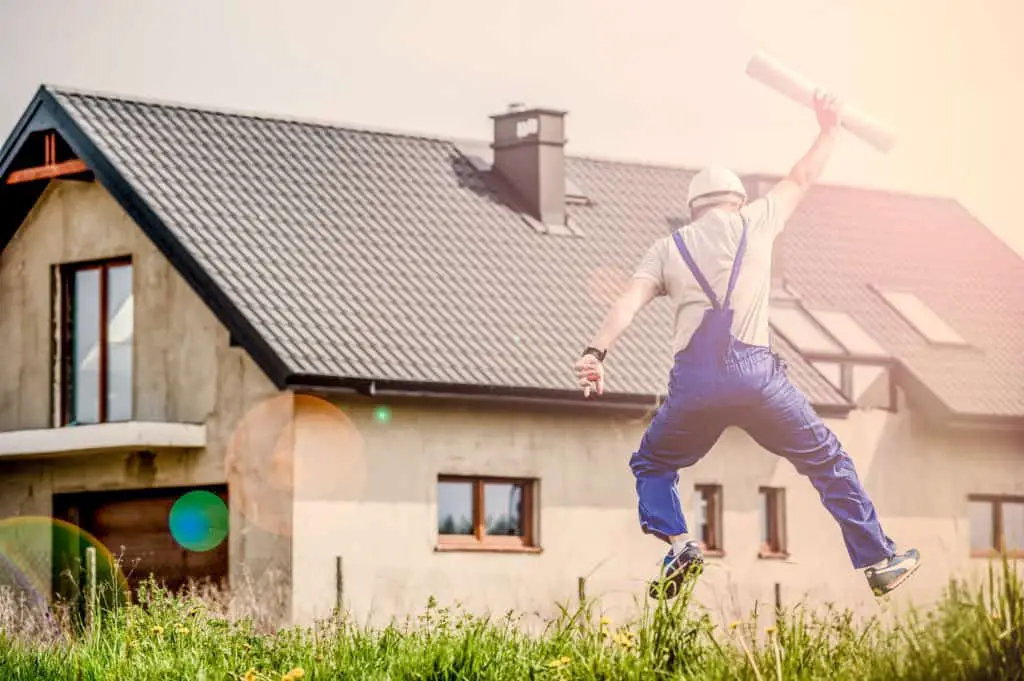
First of all, your house isn’t going to last forever. This means that many of the materials that you use in the construction of your house will eventually be removed.
Even if the house lasts for hundreds of years, many of the materials you’ve used will eventually be replaced. If they’re not eco-friendly, they can have a significant impact on the environment (and not in a positive way).
Not to mention that by purchasing materials that are not eco-friendly, you’re contributing to the pollution of the earth and the destruction of the environment that occurs in obtaining, manufacturing, and/or transporting those materials.
With that in mind, the following are some of the main reasons why you should use eco-friendly building materials in the construction of your new home – or in any home improvement projects that you decide to invest in:
1. Minimize waste

One way to ensure that the materials you’re using are eco-friendly is by using recycled materials. There are many types of materials that you can use that are made using recycled elements.
For example, recycled steel, drywall, plastic, glass, and rubber are all materials that can be used in the construction of your new home, whether it’s for something as minor as your kitchen countertops or something as important as your home’s walls.
When you use materials that are recycled, you are saving materials from disposal, which means you’re preventing them from filling up landfills, polluting the environment, and posing a serious threat to wildlife.

Buying materials from around the world for the construction of your home is not an eco-friendly practice. When possible, you should try to buy materials that are locally produced or manufactured.
This is because the further away these materials are, the more you’re contributing to travel-based pollution.
Materials have to be shipped by boat, plane, and/or truck, after all. The further they have to be transported, the more fuel is used up and the more you contribute to CO2 (carbon dioxide) emissions.
3. Stop contributing to unsustainable practices

Certain building materials are more sustainable than others in that they won’t affect the environment in a negative way in the future.
The use of recycled materials also means that you’re not contributing to the negative impact on the environment that the production of new materials might have.
For example, the use of rare wood species from across the world for your flooring is not a sustainable practice since you are contributing to the deforestation and production of wood (a large amount of energy is used to dry and process wood).
Using a more sustainable alternative or reclaimed wood ensures that you’re reducing the contribution to potential environmental harm as much as possible.
4. Improve your home’s resale value

Over the past few years, people have become more aware of how the environment is impacted by their behavior. This has led to more people becoming more environmentally responsible.
People, in general, are more informed than they’ve ever been before. They understand how an eco-friendly home can help reduce their maintenance and utility costs as well as improve their quality of life.
As a result, homebuyers are not only looking for eco-friendly homes, they are willing to pay a premium for them.
Many studies have proven this to be true, including a study in California funded by the Pacific Gas and Electric Company, which showed that green-certified homes are sold for higher prices than those that are not.
5. Improve your family’s quality of life

The quality of your home’s indoor air can directly affect the health of your household.
Children, seniors, and anyone with existing health issues can be affected by poor quality indoor air.
While there are many things that can contribute to poor indoor air quality (such as a subpar HVAC system), one factor that’s often overlooked is the materials used in the building of your home.
This is because some materials contain VOCs (volatile organic compounds). VOCs are chemicals that occur naturally but can cause health problems in large concentrations.
Some materials that may contain VOCs include common house paints and finishes. Even some solid building materials, such as building partitions, may contain VOCs.
It’s important that you avoid using materials that contain chemicals such as these that can be harmful to the environment as well as to your family’s health.
6. Reduce maintenance needs

In many cases, cheaper materials are used as a way to save money during home construction.
Unfortunately, cheaper materials tend to be of lower quality and are rarely eco-friendly.
Eco-friendly materials are often much higher quality, which means that repairs are not required nearly as often.
For example, the use of recycled steel instead of standard wood can help reduce the need for repairs and replacement over the long-term.
The use of recycled rubber or clay tile for your roof will be less vulnerable to damage and will last longer than less eco-friendly options, such as asphalt shingles.
What eco-friendly building materials should you use?
So now you know why it’s so important that you use eco-friendly materials when building or remodeling your home.
But what eco-friendly building materials should you use?
The following are some of the building materials that you should consider using and why they are considered so eco-friendly:
Bamboo

Bamboo is a beautiful material that reminds a lot of people of wood. Outside of its aesthetic benefits, bamboo is also very durable – even more durable than some wood species.
It’s also quite resistant to water damage. Combined, the benefits of bamboo make it an excellent option for flooring.
Bamboo has also become a very popular alternative to wood flooring due to how sustainable bamboo is. Unlike wood, bamboo does not come from trees.
Bamboo is actually a grass that grows naturally in almost all kinds of climates around the world, which means there’s no shortage of bamboo.
The fact that it grows rapidly (it takes as little as five to seven years to fully mature) as well means that it’s a highly renewable resource.
The only thing you need to be careful about is who you purchase your bamboo flooring material from. This is because some manufacturers use adhesives in their bamboo floor planks that may contain high levels of VOCs.
As long as you avoid this, bamboo is an incredibly eco-friendly option.
Cork

Cork is a material that’s still not used as much as it arguably should be.
There are several different ways that cork can be used as well. For example, cork is an excellent insulating material as well as a flooring material.
Because cork is such a good insulating material, when used as flooring, it won’t undergo the drastic temperature changes during the winters and summers as other flooring materials do.
Cork flooring is soft to the touch yet durable, making it one of the most comfortable flooring materials to walk across in your bare feet.
Additionally, cork is resistant to fire (it will only melt or ignite if exposed to very high temperatures) as well as resistant to mold, mildew, and termites.
But what makes cork so sustainable?
It comes from the bark of cork oak trees. When you strip the bark off of a tree, it will eventually grow back, which means you’re not actually damaging the tree.
As a result, cork is a renewable resource.
If that wasn’t enough, there are also companies that provide recycled cork building materials, which are made from recycled corks used in wine bottles.
The only potential drawback is that most of the world’s cork supply comes from Portugal, which means you are contributing to the use of fuel required to transport cork; however, cork is incredibly light, which means it doesn’t require nearly as much energy to ship as other materials.
Because of its insulating properties, cork will also help keep your energy costs down by keeping the heat and cold air your HVAC system produces from escaping your home.
Recycled steel

When you think of steel, odds are you don’t think of it as a material that is eco-friendly. After all, in order to produce steel, ore has to be mined, which tends to be a very polluting process.
Not to mention that the production of steel results in energy consumption and carbon dioxide emissions as well.
While the steel industry has made great strides over the past few decades in making their manufacturing processes less harmful to the environment, this is still a concern when it comes to choosing steel as a sustainable material.
However, steel also happens to be infinitely recyclable – without any loss of quality. This means that you can avoid contributing to energy consumption and carbon dioxide emissions by using recycled steel for your construction.
You can use 100 percent recycled steel to build the frame of your house as an alternative to wood.
Not only will steel last much longer than wood, but it can also be continually recycled for other purposes.
As a building material, steel is also more durable and more resistant to things like fire, mold, mildew, rot, and termites than many other alternatives
This means that much less maintenance will be required to keep your home in good condition and you’ll rarely if ever have to replace any of the steel you use.
According to the Steel Recycling Institute, a 2,000-square foot home would require the use of 40 to 50 trees if built using wood. If you use recycled steel instead, you’ll end up using the equivalent of six scrapped vehicles.
Recycled glass
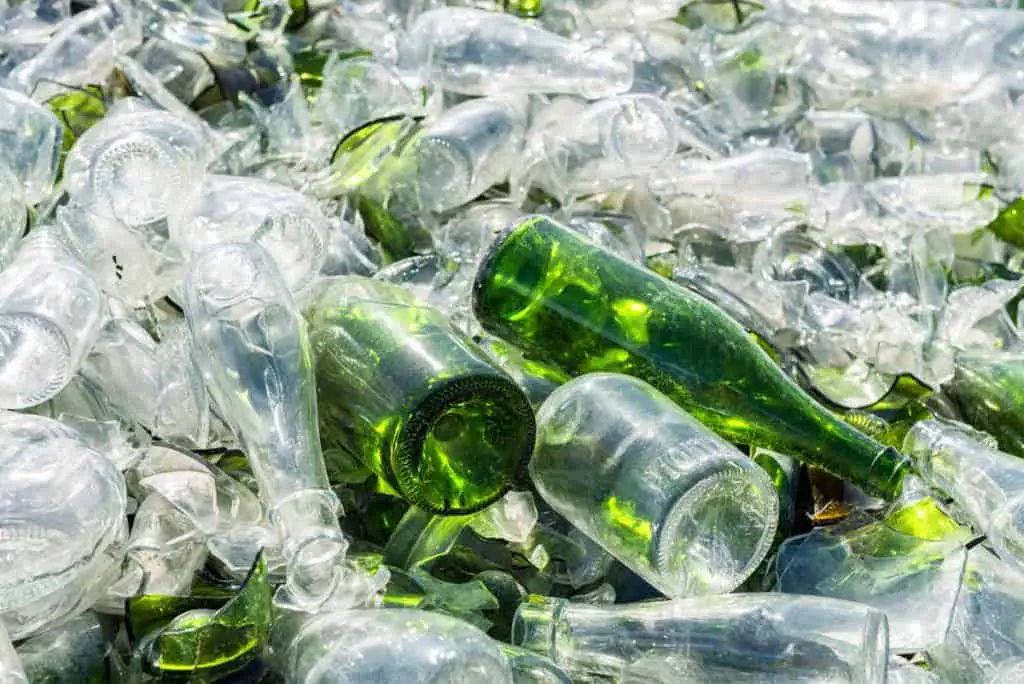
There’s no way to avoid using glass in your home construction unless you decide you don’t want windows (and not having windows is obviously a bad idea for countless reasons).
Unfortunately, the production of glass isn’t the most eco-friendly. The melting activities required in the production of glass results in CO2 emissions.
Nonrenewable raw materials, such as sand and minerals, are also required to produce glass.
Fortunately, the glass manufacturing industry has been implementing new technologies to help reduce their impact on the environment.
Nevertheless, you should consider using recycled glass wherever possible.
For example, you can use recycled glass tiles for your kitchen and bathroom floors, walls, backsplashes, and countertops.
You may even be able to find a local vendor that sells 100 percent locally recycled glass.
Just make sure that if you do purchase recycled glass tiles, that they are made using VOC-free pigment.
By using recycled glass, you’re not contributing to some of the environmental harm involved in the production of new glass.
Additionally, the use of recycled glass won’t result in a loss of quality. This is because there’s no downcycling involved (a process in which a material is broken down to be recycled, causing a loss in quality).
Sheep’s wool

Sheep’s wool has been used by clothing manufacturers for many years to produce clothing that’s not only comfortable, but warm as well. The ability to keep people warm is a result of the wool’s insulating properties.
In fact, it’s such an effective insulating material that it can be used as insulation for your home’s walls, ceilings, and attic.
It also happens to be fire-resistant, which is perfect for ensuring the safety of your home.
There are several reasons why sheep’s wool is also an eco-friendly material:
First of all, it’s a renewable resource. Once a sheep has been sheared, its wool will just grow back.
Secondly, the overall production process required by sheep’s wool uses 15 percent less energy than the process used to manufacture glass wool. Thirdly, sheep’s wool is biodegradable.
Finally, using sheep’s wool as insulation for your home will contribute to a much healthier indoor environment.
This is because sheep’s wool will absorb harmful pollutants, including formaldehyde, nitrogen dioxide, and sulfur dioxide.
On top of that, sheep’s wool will help regulate humidity by absorbing 33 percent of its weight in moisture – all without diminishing its insulating properties.
Reclaimed wood
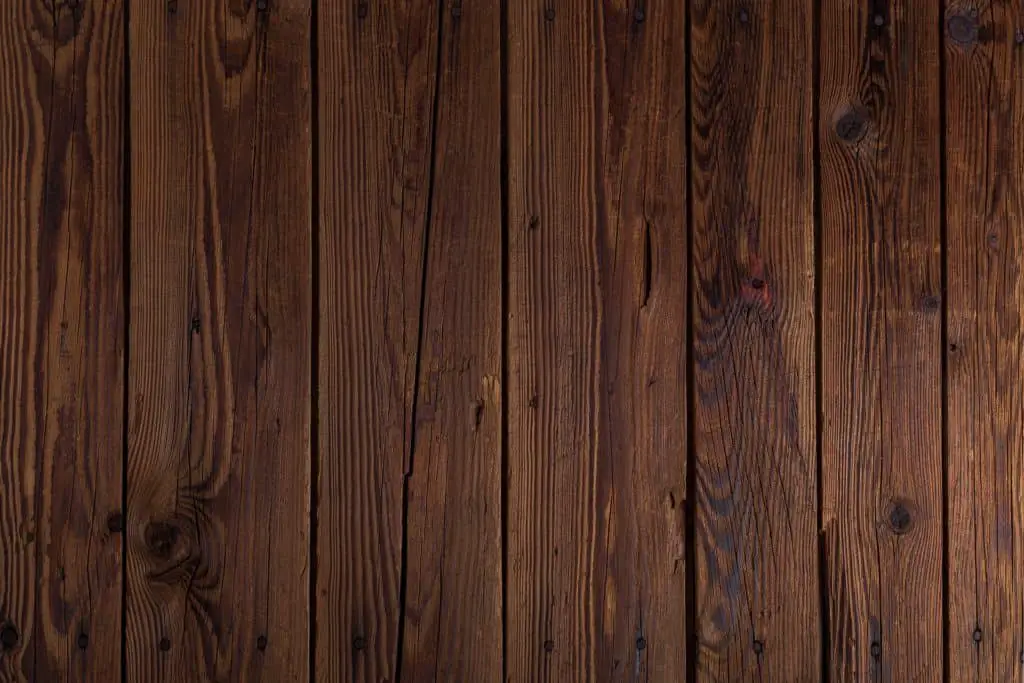
In general, wood is very eco-friendly; however, it’s often not a sustainable material.
This is because wood has to be cut down and processed before being transported to your location. Trees that are cut down take a very long time to regrow.
This is unfortunate because wood is one of the highest quality materials you can use in the building of your home.
Wood can be used for flooring, siding, roofing, cabinets, doors, and much, much more. Wood has been used in construction for thousands of years due to its durability and its unique visual appeal.
Fortunately, you can still use wood as a building material. One sustainable method for using wood is by using reclaimed wood.
This involves using wood that was used in previous construction projects. For example, wood from an old farmhouse or from an old dock that was torn down in your area.
Not only are you reusing wood to prevent further deforestation and unsustainable manufacturing processes (such as the use of refining chemicals in lumber production), but by buying your reclaimed wood from a local source, you help reduce your carbon footprint even further.
Reclaimed wood can be reused in your home’s construction and can provide an even more unique aesthetic as a result of its aged and weathered appearance, which helps to provide character that newer wood doesn’t always have.
In fact, many people leave their reclaimed wood unpainted and unstained as a result, which helps limit VOCs.
FSC-certified wood
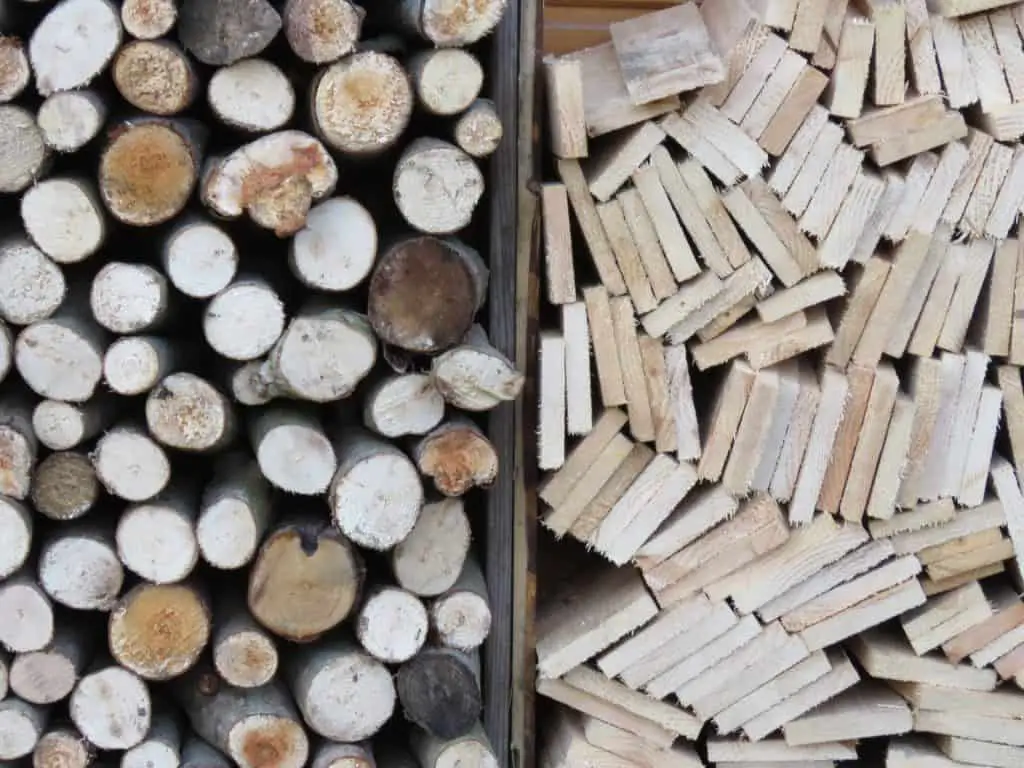
If you really want to use wood in the construction of your home because of its distinctive visual appeal and you don’t want to use reclaimed wood (it can sometimes be difficult to match the exact look you’re going for when limiting yourself to local reclaimed wood), then make sure the wood you source is FSC-certified.
The FSC (Forest Stewardship Council) is a non-profit organization that certifies wood products based on their ability to meet the highest environmental and social standards, including responsible forestry.
When you use FSC-certified wood, it means that you’re not contributing to deforestation, illegal logging practices, clear-cutting (a process in which all trees in a tract are removed), or pesticide use.
The FSC also ensures that the wood wasn’t sourced by a company that’s disrespecting native cultures or economies.
Additionally, the FSC also monitors the chain of custody to ensure that the wood you’re using actually came from the forest that was certified. Basically, FSC-certified wood is coming from a sustainable source.
Linoleum

Linoleum has long been a popular flooring option for kitchen and bathroom spaces due to how easy it is to maintain. The material is anti-microbial and water-resistant and can be easily cleaned off.
Visually, linoleum can be produced to look like whatever you want it to look like. On top of all of that, it’s also relatively affordable, especially when compared to other flooring options.
What might come as a surprise to some people, however, is that linoleum is incredibly eco-friendly.
Linoleum is made from a variety of different materials, all of which are natural, easily renewable, and biodegradable. These materials include:
- solidified linseed oil (made from flax seeds)
- ground cork dust
- rosin (a resin tapped from pine trees without causing damage to the trees)
- limestone (a natural stone)
- wood flour
- eco-friendly pigments
Despite all of the benefits, there are some things to be wary of when purchasing linoleum flooring.
First of all, linoleum flooring is often installed using an adhesive. If this is the case, make sure that a non-toxic adhesive is used that meets low VOC requirements and that is solvent-free.
Secondly, when shopping for linoleum flooring, make sure you’re actually looking at linoleum flooring products.
Many retailers still advertise vinyl tiles as linoleum. These are not real linoleum products and are not eco-friendly at all (in fact, vinyl is made from PVC which is toxic).
Recycled rubber
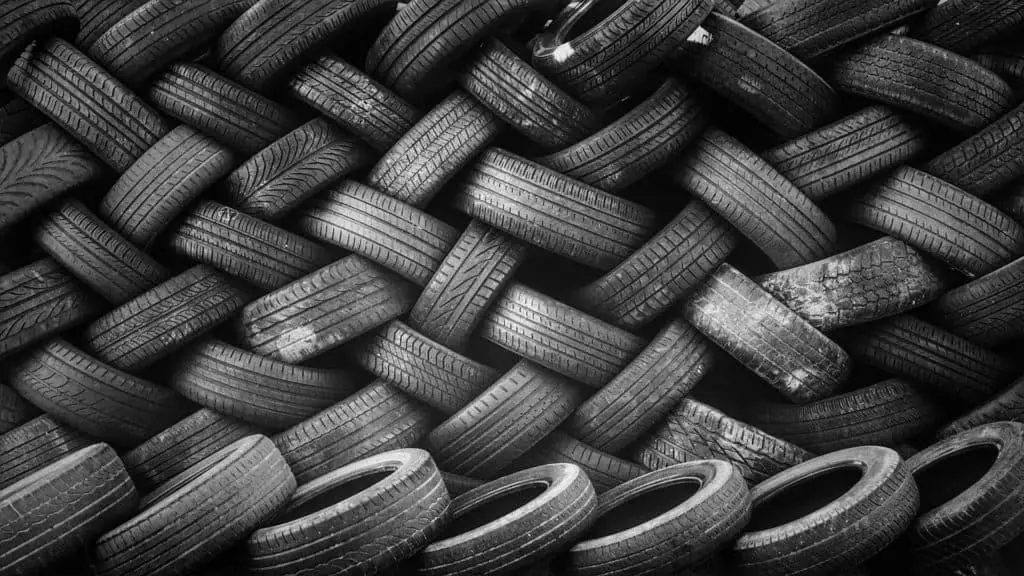
As far as sustainable materials go, rubber is not a good option. The production of rubber causes all kinds of problems for the environment.
First of all, the production of rubber has been responsible for extreme deforestation, especially in South East Asia.
The EPA has also labeled the rubber tire manufacturing industry as a major source of hazardous air pollutant emissions.
Although rubber is made from natural resources, most rubber products, such as tires, will take a very long time to decompose.
Considering the fact that over 300 million rubber tires are scrapped every year, this is a problem. It’s also why you might want to consider using recycled rubber for your roofing material.
Using recycled rubber for your roof is a good way to prevent even more rubber tires from going to the landfills. This makes the use of recycled rubber a very eco-friendly thing to do. Recycled rubber shingles are made from the tread section of rubber tires.
Recycled rubber tiles are very durable and will generally last at least 30 years (it’s not uncommon for recycled rubber tile roofs to come with 30-year warranties, which means that they can last even longer than that).
They are lightweight, easy to maintain and repair if needed, and highly resistant to weather-related damage. Recycled rubber can also be used as a flooring material.
Recycled drywall

Drywall is the material commonly used to build interior walls and ceilings. It’s a more affordable and practical option than using wood, concrete, or brick for these areas of the home.
By itself, drywall is pretty eco-friendly already. The drywall cores consist of up to 95 percent recycled material, much of it reclaimed drywall.
The paper exterior is usually made from 100 percent recycled content. Unfortunately, the process for manufacturing drywall consumes a lot of energy and produces a lot of CO2 emissions.
However, there are drywall manufacturers out there that have made significant progress towards making their manufacturing process more sustainable. Take for instance USG’s EcoSmart drywall panels.
Their lightweight panels are fire-resistant and are made using 94.6 percent recycled content. The EcoSmart panels boast upwards of 25 percent less global warming potential, use up to 25 percent less water in their manufacturing process, and reduce transportation fuel energy by up to 20 percent as a result of their lightweight construction.
Additionally, the panels are GREENGUARD Gold Certified and qualify as a low VOC emitting material.
Cellulose insulation

There are a lot of eco-friendly solutions when it comes to insulating your home; however, cellulose insulation is one of the (if not the) most eco-friendly options out there.
Cellulose insulation is made from 85 percent recycled materials, including newspaper and other types of paper.
These materials would otherwise have decomposed in a landfill, contributing to the release of harmful greenhouse gases into the atmosphere.
It’s estimated that if all of the paper that is dumped into the world’s landfills were to be converted to cellulose insulation, it would reduce CO2 emissions by as much as eight million tons.
Producing cellulose insulation requires very little energy as well.
Natural Stone
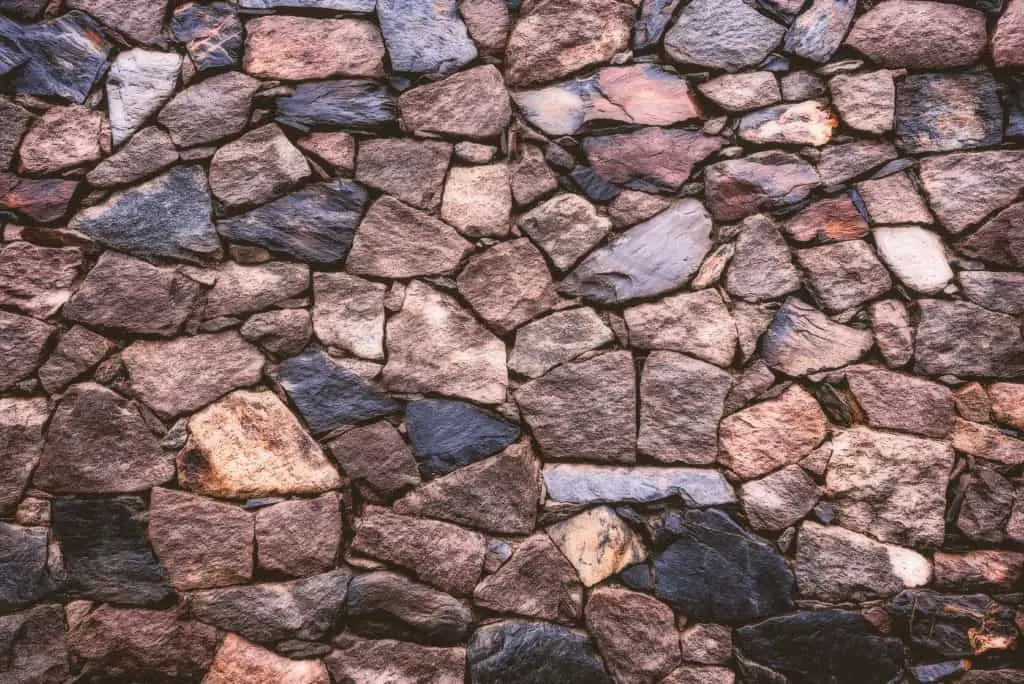
Natural stone is a natural material that does not require a manufacturing process to produce.
While its quarrying and extraction does require some energy consumption, technological advancements have helped the sustainability of the stone industry by helping to minimize waste, prevent pollution, and conserve resources.
Natural stone can also be easily recycled or repurposed after use. There are many reasons to consider using natural stone.
It’s incredibly durable and there are many types of natural stone to choose from, such as granite, slate, and marble, just to name a few.
Stone is easy to care for and will withstand an incredible amount of wear and tear. As such, it can be used as a building material for all kinds of applications, from your outdoor walkways, patios, and retaining walls to your floors and countertops.
Natural stone – specifically, slate – is even a great option for roofing material due to its immense durability and resistance to damage.
You could argue that the only disadvantage is that natural stone is incredibly heavy, which means that transporting natural stone building materials can consume a lot of fuel and result in a lot of CO2 emissions; however, if you source your natural stone from a local supplier, you can minimize this impact.
Clay tiles

Clay tile roofs are very popular for certain home designs, such as Mediterranean-style homes. This is in part because of its classic look, which draws the eye.
It’s also because of its resistance to salt and heat. In fact, the heat resistance of clay tile contributes to its eco-friendliness. Clay tiles prevent heat from penetrating through the home, thereby helping cut down on energy costs.
But it’s the material clay tiles are made of that makes it truly eco-friendly.
Clay is made from earth and contains no chemicals or petroleum products, which means that it’s a renewable resource that can be 100 percent recycled after use.
If that wasn’t enough, clay tiles last longer than almost every other type of roofing material – up to 100 years in many cases.
Learn more about eco-friendly roofs in our article here.
Pre-cast concrete
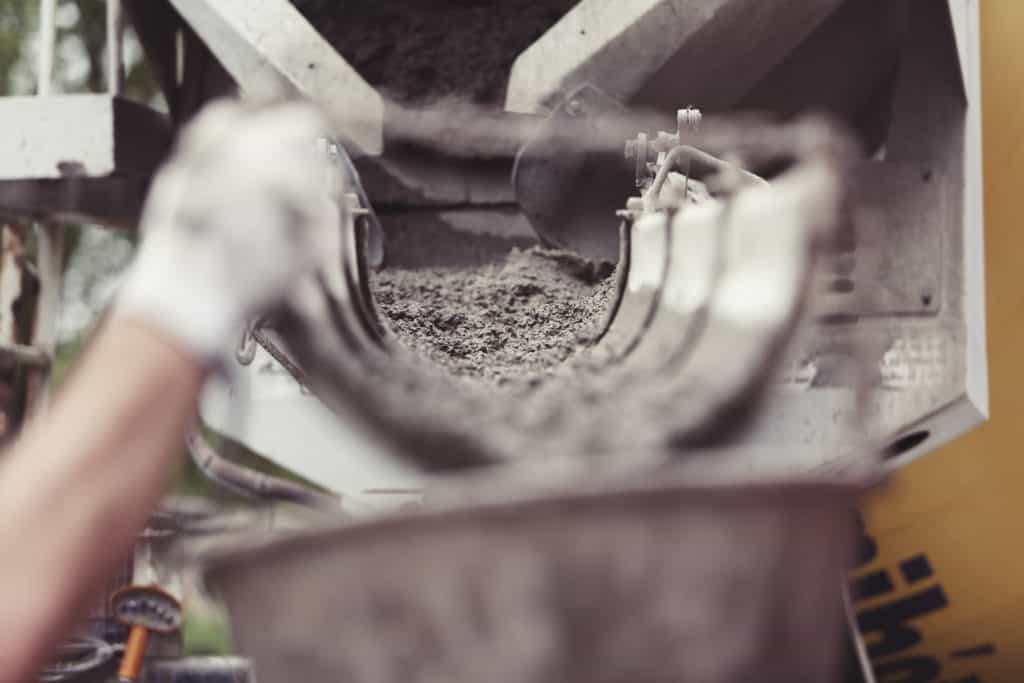
Concrete, in general, is a material that’s difficult to avoid in new construction. You’ll want to use concrete for your driveway, your garage floor, and perhaps for flooring in other areas of your home as well. Concrete can also be used for patios and walkways.
The main reason why concrete is the most commonly used material in areas like these is due to its strength and durability – it’s completely resistant to fire, water, and termites.
Unfortunately, the manufacturing of cement does involve the emission of CO2. However, you can minimize the impact you have on the environment by using pre-cast concrete.
Pre-cast concrete is a more eco-friendly alternative to the traditionally poured concrete because it results in much less waste. When pouring concrete on-site, there tends to be a lot of spillages and wasted cement remnants in the cement truck.
With pre-cast concrete, steel molds are built to the exact dimensions so that the cement can be carefully poured off-site. The pre-cast concrete slabs are then transported to your home where they are installed.
These steel molds can be reused over and over again, whereas when poured on-site, temporary wooden frameworks will be built, which will then be thrown out after use.
While there are some drawbacks to the production of cement, high-quality concrete (such as pre-cast concrete) can last upwards of a century, making it a more sustainable option than traditionally poured concrete as well as other materials.
Soy-based materials

Soybean-based building materials have seen a surge in popularity over recent years. For example, many manufacturers are using soy-based resins in their VOC-free paints, sealers, and paint removers.
Soy-based resins are also being used to help bind together materials in countertops. Even more popular is soy-based foam insulation.
One of the reasons why soy is so eco-friendly is because it’s derived from soybeans, which are a renewable resource. Soy also replaces the use of petroleum commonly found in insulation and isn’t produced using any chemicals that could harm your indoor air quality.
There is one potential drawback to the use of soy-based building materials. The demand for soy-based products has led to increased soybean farming around the world.
In the U.S., soybean farmers have been continuously improving sustainable farming practices. However, in South America, where soybeans are a huge export, the demand for soybeans has resulted in massive deforestation.
If you are going to use soy-based building materials, you may want to make sure that the soy material being used is obtained from U.S. sources to ensure that your materials are coming from a sustainable source.
FAQ about eco-friendly building materials
Sustainable materials are materials that can be effectively used in the present without compromising their availability in the future.
For example, many sustainable materials are natural resources that are easily renewable, such as bamboo or cork, while other sustainable materials, such as steel, can be used over and over again.
No. Materials that are eco-friendly are materials that don’t cause harm to the environment through their use.
For example, wood is technically an eco-friendly material because it is a natural part of the environment. There are no chemicals that are harmful to the environment inside of wood.
However, sustainability refers to the future impact that a material has on the environment. If a company is chopping down trees at a faster rate than it’s replanting them in order to obtain wood, then the wood it’s collecting and selling is not sustainable.
To be considered sustainable, the material must be considered renewable. Recycled materials are also considered sustainable.
The use of sustainable materials isn’t the only thing that makes a building sustainable. The building must also be designed to conserve water, energy, and materials.
No, but there are exceptions. Wood is sourced from trees that are cut down. The wood industry has resulted in massive deforestation around the globe, which has displaced all kinds of wildlife.
However, there are environmentally responsible ways to use wood: you can use reclaimed wood or you can purchase FSC-certified wood, which ensures that the wood comes from sustainable sources.
Yes. In fact, materials that were not eco-friendly initially can find a second life when recycled for use in construction.
By using such recycled materials, you’re helping to prevent the materials from piling up in landfills or being discarded into the environment where they can cause serious damage.
Recycled materials such as rubber, glass, steel, drywall, and more make for effective building materials.
Yes. Cork is completely sustainable. This is because even though it’s sourced from trees, it’s made from the bark and not the trees themselves.
Once bark has been stripped from a tree, it will simply regrow. As such, it’s a renewable resource.
It’s also a high-quality material in itself as a result of its durability, softness, and insulating properties.
Yes. Like cork, bamboo is also a natural, sustainable material.
Bamboo is a grass that grows in most climates across the globe at a fast rate, which makes it an easily renewable resource.
It also has many of the same benefits of wood, including durability and visual appeal.
Sometimes. It depends on how available the materials are. For example, some natural stones are more expensive than others.
However, some eco-friendly materials are actually cheaper. Recycled materials tend to be more affordable because you’re essentially using “used” materials.
Price isn’t very indicative of whether or not a material is eco-friendly, sustainable, or of high quality.
There are many factors that lend to the cost of building materials in general.
It can. Using materials that have been recycled will often be more affordable.
For example, using reclaimed wood can be a lot more affordable than using specific species of wood sourced from other parts of the world.
No. There’s no sacrifice in the quality of a material in order for it to be eco-friendly. In fact, many eco-friendly materials are sustainable as well, which means that they are much more likely to last and will not require nearly as much maintenance as other materials might.
Yes. Your quality of life can improve as a result of eco-friendly building materials. Certain materials may contain VOCs, which are harmful to your health.
Reducing the amount of VOCs in your home will improve the quality of your indoor air.
Yes. Whenever possible, buy building materials from a local source. Doing so limits the distance that the materials have to be shipped.
Transportation impacts the environment as a result of fuel use as well as CO2 emissions.
There are several eco-friendly roofing materials available. Any shingles made from recycled materials, such as rubber, are a great eco-friendly option.
Clay tiles and metal roofing are both considered very eco-friendly as well as sustainable materials.
There are tons of eco-friendly flooring options. Reclaimed wood, FSC-certified wood, cork, bamboo, and flooring made from recycled materials are all eco-friendly, sustainable options.
Conclusion
Whether you’re planning to build a new or home or you’re simply investing in a remodel, do your research when it comes to deciding on what materials to use.
There are thousands of materials to choose from for every aspect of your home, and you’ll want to make sure that the materials you use are as eco-friendly and sustainable as possible.
By using the materials mentioned in this article, you’ll reduce your carbon footprint, reduce waste, help the environment, contribute to a sustainable future, improve your quality life, and even increase your home’s value.
Not to mention that an eco-friendly home is a home that you can be proud to live in.
Be sure to check out our article on the 12 key things you can do to make sure your home is eco-friendly.
You Might Also Like…
- Is Fast Food Bad for the Environment? (& What You Can Do)
- Is Fabric Softener Bad for the Environment? (+5 Eco-Friendly Options)
- Is Fuel Dumping Bad for the Environment? (& How Often It Happens)
- Is Electricity Generation Bad for the Environment? (What You Should Know)
- Is Dry Cleaning Bad for the Environment? (4 Surprising Facts)
- Is Diamond Mining Bad for the Environment? (Important Facts)
- Is DEET Bad for the Environment? 4 Effects (You Should Know)
- Is Cat Litter Bad for the Environment? (5 Common Questions)
- Is Burning Cardboard Bad for the Environment? (6 Facts)
- Is Burning Paper Bad for the Environment? (6 Surprising Facts)
- Is Burning Leaves Bad for the Environment? (7 Quick Facts)
- 4 Natural Cleaners for Quartz Countertops
- 6 Eco-Friendly Acrylic Paint Brands (For Sustainable Artists)
- 5 Eco-friendly Alternatives to Acrylic Paint (& How to Make Them)
- Is Acrylic Paint Bad for the Environment? (7 Quick Facts)
- Is Acrylic Yarn Bad for the Environment? 8 Crucial Facts
- Is Acrylic Bad for the Environment? (8 Quick Facts)
- Is Aluminum Foil Bad for the Environment? 7 Quick Facts
- Is Bleach Bad for the Environment? 6 Crucial Facts
- Is Lithium Mining Bad for the Environment? 6 Crucial Facts
































